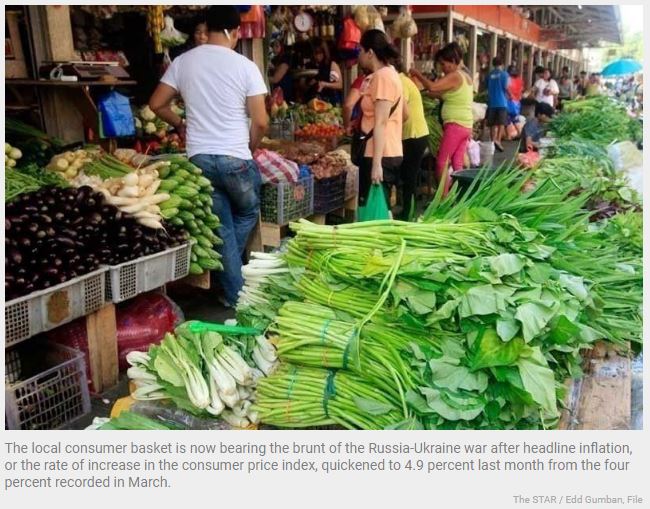Philippines: Inflation spikes to 4.9% in April, highest in 3 years
MANILA, Philippines — The continued price pressure due to global tensions pushed the country’s headline inflation to 4.9 percent in April, its highest rate in over three years, with its downtrend still unlikely in the months ahead.
The local consumer basket is now bearing the brunt of the Russia-Ukraine war after headline inflation, or the rate of increase in the consumer price index, quickened to 4.9 percent last month from the four percent recorded in March.
The Philippine Statistics Authority (PSA) said the latest print was the highest in more than three years or since the 5.2 percent recorded in December 2018.
The April inflation also breached the market consensus at 4.6 percent and settled at the upper end of the central bank’s 4.2 to five percent forecast for the month.
Inflation for the January to April period now averages at 3.7 percent.
In a briefing yesterday, National Statistician Dennis Mapa said initial monitoring of PSA revealed that a downtrend shift in inflation has yet to be observed.
“We have yet to see a shift, even if we are seeing a reduction in the prices of gasoline and diesel. We cannot really say that there will be a shift in that direction,” Mapa said.
While the PSA cannot quantify the impact of rising fuel prices on other commodities, Mapa said such increases are already evident in the subgroups of food and non-alcoholic beverages, transport, and housing, water, electricity, gas and other fuels.
These three major sources contributed almost 85 percent to the April inflation.
The heavily weighted food and non-alcoholic beverages contributed the highest share to the uptrend at 51.5 percent. Food inflation increased to 3.8 percent from 2.6 percent on higher prices of vegetables, tubers, meat, fish and other seafood.
Mapa said the PSA is closely looking at rice prices given its biggest weight in the food basket. As of now, rice inflation remained at 1.6 percent.
“Once rice starts increasing, the food basket will really increase and contribute to higher inflation,” he said.
Upside pressure remains on the transport subgroup, with inflation accelerating to 13 percent from 10.3 percent, contributing 27.8 percent to overall inflation.
Diesel also soared to an over three-year high of 83.7 percent, while gasoline rose to 43 percent as oil prices in the world market have yet to stabilize. Passenger transport by sea also jumped 13.6 percent from a deflation of 5.9 percent in March.
“While the weight of transport in general is just nine percent, there will really be an impact in the prices of other goods, especially on food products,” Mapa said.
Inflation for housing, water, electricity, gas and other fuels, which shared 17 percent of the uptrend, rose to 6.9 percent from 6.2 percent in March, driven by liquified petroleum gas, electricity and rentals.
In a statement, Socioeconomic Planning Secretary Karl Chua said global commodity prices remain high as a consequence of the ongoing war.
But Chua noted that the government is fast tracking its set of interventions to mitigate the impact of rising commodity prices on the domestic front.
The Economic Development Cluster has already put in place policy interventions to manage supply and prices of key commodities.
These include the reduction of tariff rates for corn, pork, and rice, as well as the importation of more wheat and production of more cassava as feed substitutes to augment the alternatives for corn.
On the transport side, the government is providing fuel subsidies for public utility vehicle (PUV) drivers and farmers to address rising fuel prices.
So far, some 180,000 PUV drivers and operators have received their P6,500 fuel subsidy, while the Department of Energy is securing between P1 to P4 per liter discounts from private oil companies.
The Department of Agriculture is also implementing a fuel subsidy program for nearly 160,000 corn farmers and fishers.
Further, the economic team has recommended the temporary reduction of the tariff rate for coal to zero percent until December, which will maintain the country’s buffer stock at the current 30 days minimum inventory.
“As we shift more areas in the country to Alert Level 1, we expect to accelerate our recovery and increase our economy’s resilience from external shocks,” Chua said.
ING Bank senior economist Nicholas Mapa, for his part, said the central bank is expected to join the rate hike club with an adjustment before the end of this quarter.
This, as faster inflation will likely persist for the entire year.
Bangko Sentral ng Pilipinas Governor Benjamin Diokno has been hesitant to increase policy rates since the pandemic started, as retaining monetary policies would support economic recovery.
“But with first quarter gross domestic product growth expected to be robust and confirming that growth momentum is intact, we expect BSP to finally move rates higher,” ING’s Mapa said.
“A GDP growth rate of over six percent on top of the above-target inflation rate should be enough to prod BSP to hike rates as early as the May policy meeting,” he said.
Meanwhile, following the trend in the national level, inflation in Metro Manila soared to 4.4 percent, while that of the areas outside NCR rose to 5.1 percent.
Consumer prices for the country’s poorest households accelerated as CPI for the bottom 30 percent income group jumped to a five-month high of 3.8 percent.
Faster growth was seen in the indexes of food and non-alcoholic beverages, alcoholic beverages and tobacco, housing, water, electricity, gas, and other fuels, clothing and footwear, furnishings and household equipment, transport, recreation and culture, and restaurant and miscellaneous goods and services.
Prices of consumer goods for the poorest households outside the capital went up to 3.9 percent while inflation in NCR increased 3.5 percent.
Source: https://www.philstar.com/business/2022/05/06/2178996/inflation-spikes-49-april-highest-3-years


 English
English




